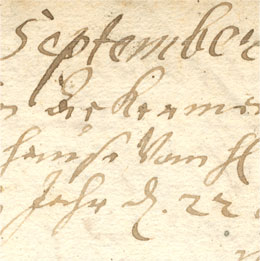Pulpit of the Karuse Church
Christian Ackermann made the Karuse church pulpit in 1697, with a joiner and a painter helping him. Claes Tott and Johann Heinrich von Derfelden commissioned the pulpit and donated it to the church. Their coats of arms are on the cartouche of the sounding board. The pulpit was redesigned at a later date.
What is known about Christian Ackermann’s works in the Karuse church?
Ackermann carved Christ as Salvator Mundi and the statues of the four evangelists to adorn the pulpit’s corpus. Ackermann similarly carved the figure of St. Peter the Apostle, and perhaps also that of St. Paul. He created the decorative putto corbels (except for one) of the pulpit’s corpus and the figures of angels with the attributes of Christ’s martyrdom standing on the sounding board, including. The figure of Christ the Invincible, which crowned the sounding board, was initially part of the pulpit’s composition but was later moved to the retable’s cornice. The pulpit’s original composition also included Moses supporting its corpus, and the statue of a pelican with its chicks, which adorned the door portal but has since been stolen from the church.
What message did the pulpit’s figures convey?
The pulpit’s supporting figure Moses symbolised the Old Testament and, above all, the validity of God’s Ten Commandments in the Lutheran Church. The statues of Christ holding a globe with a cross and blessing the world, or Salvator Mundi, the evangelists Matthew, Mark, Luke and John, and the apostles Peter and Paul point to the New Testament and the teaching of the pure Gospel. The pelican feeding its chicks with its own blood and the angels with the attributes of Christ’s suffering symbolise Christ’s sacrificial death and the eternal life of Christ the Invincible in Christianity.
What happened to the Karuse church pulpit?
The clumsy joint connecting the pulpit’s corpus to the staircase’s balustrade, distorting the pulpit’s corpus and figures, and many other details indicate that the pulpit was relocated in the church. The pulpit may originally have been located either in the church nave on its southern side or on the northern side of the chancel arch. In the latter case, the stairway would have had to start from the chancel.
The relocation of the pulpit was evidently connected to the completion of the new retable in 1787. Figures from the pulpit were most likely used to adorn it: the statue of John the Evangelist, who was given a new, very artlessly carved hand to replace his lost hand, and the statue of Matthew the Evangelist, part of whose head had been lost and had thereafter been repaired, were raised up onto the retable’s cornice. Christ the Invincible, who had previously crowned the pulpit’s sounding board, was placed between them. An angel that had originally stood at the edge of the sounding board was placed at the tip of the sounding board to replace Christ the Invincible. The pulpit’s iconographic programme changed as a result of this last replacement. The optimism in relation to the future that was characteristic of baroque religious art disappeared: when an angel holding a spear, an implement that had been used to torture Christ, crowns the pulpit and not the statue of Christ defeating sin and death, the message has clearly changed.
A new statue that was clumsier than Ackermann’s earlier figures appears to have been carved in place of Matthew, who had been removed from the pulpit. Since the attributes of Matthew’s figure and the manner in which he was cut greatly resemble the figure of Paul standing on the balustrade, his statue may also be secondary. At the same time, there is also another possibility: the statues of Matthew and Paul do indeed date from Ackermann’s time, but some assistant of his had carved them. (In such a case, the statue currently situated on the retable and thought to be Matthew would be someone else altogether, for instance John the Baptist, who is also sometimes depicted with a book.) Polychromy analysis of the figures supports this version.
Additionally, the originally polychromic pulpit was covered with white, dark blue and beige paint. Only one putto head of the balustrade has retained its baroque colouring.
A new fateful blow struck the Karuse pulpit in the Soviet era: the statues of Salvator Mundi and Mark the Evangelist were stolen from the pulpit’s corpus, while the statue of Moses was stolen from beneath the corpus and the statue of the pelican was stolen from the door portal.
